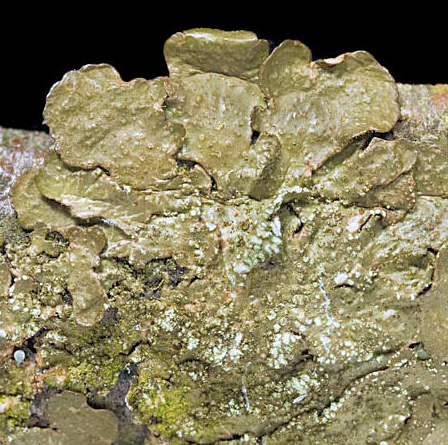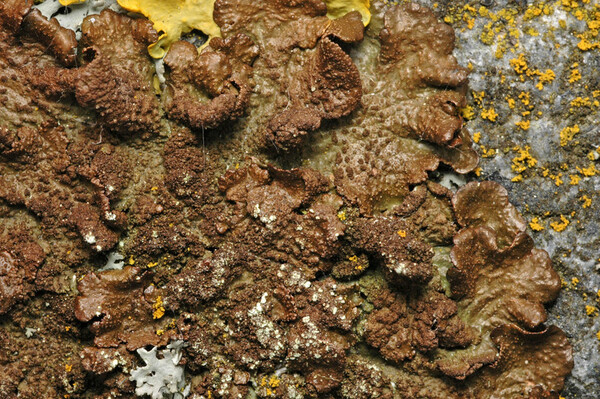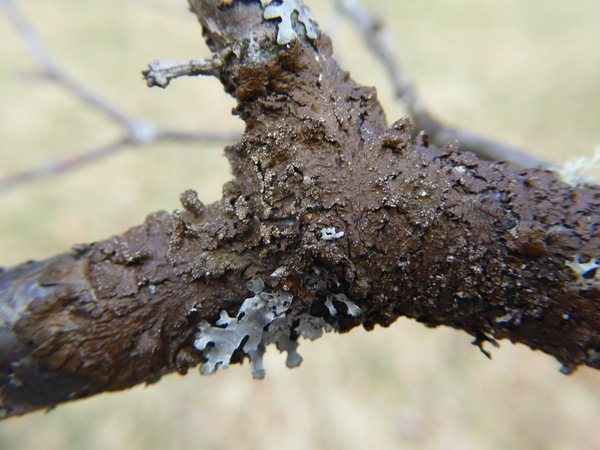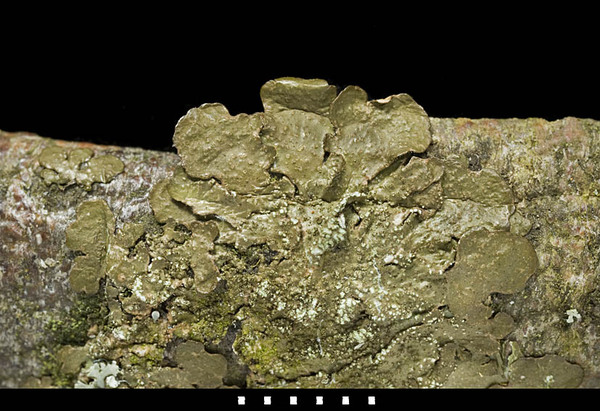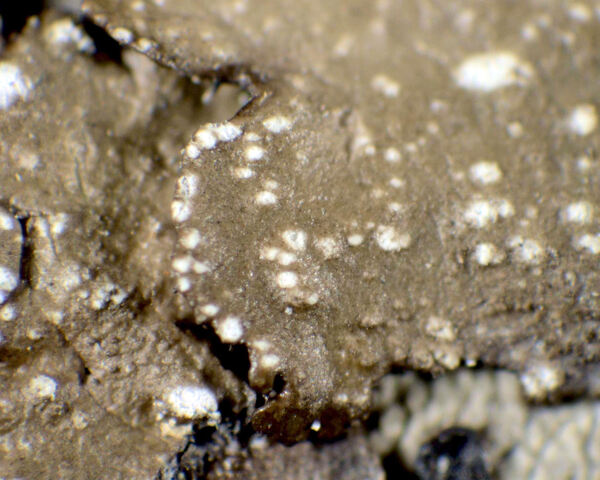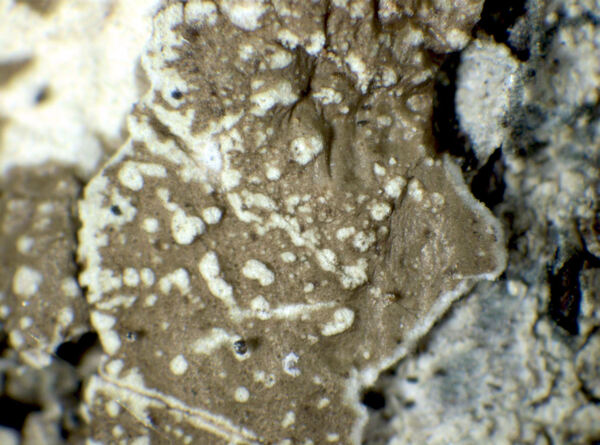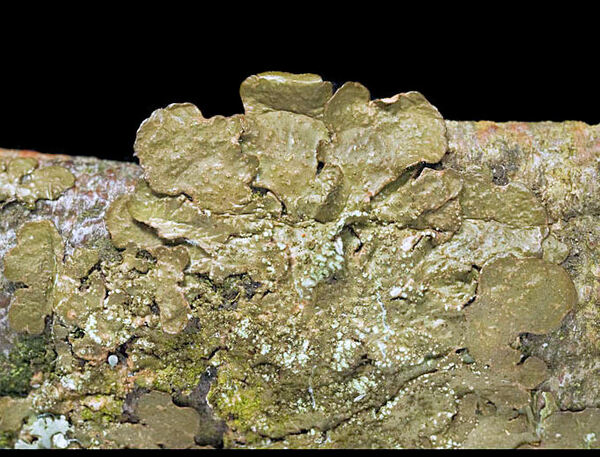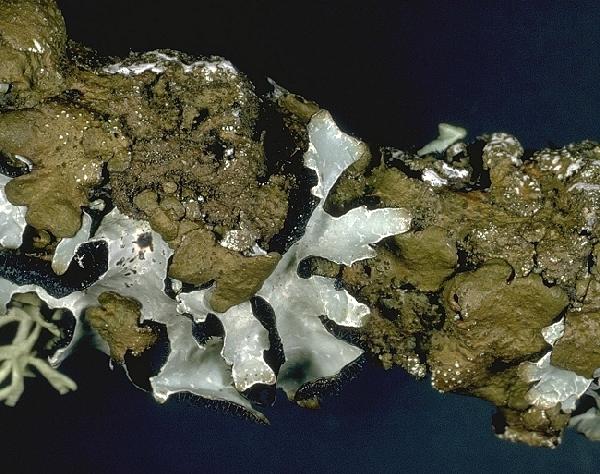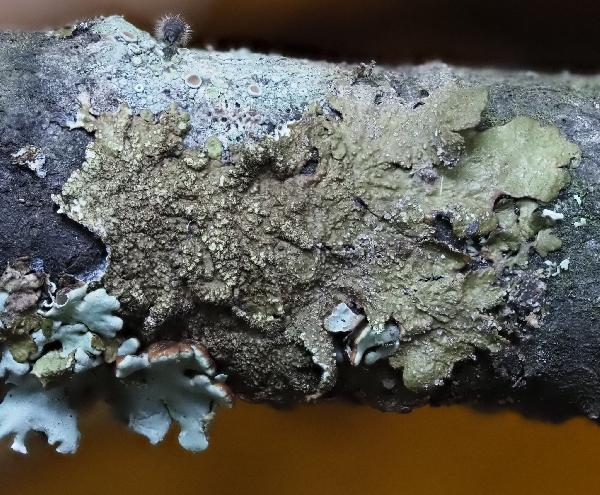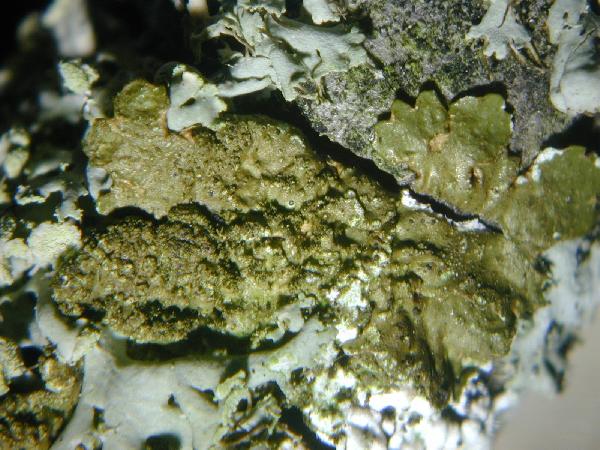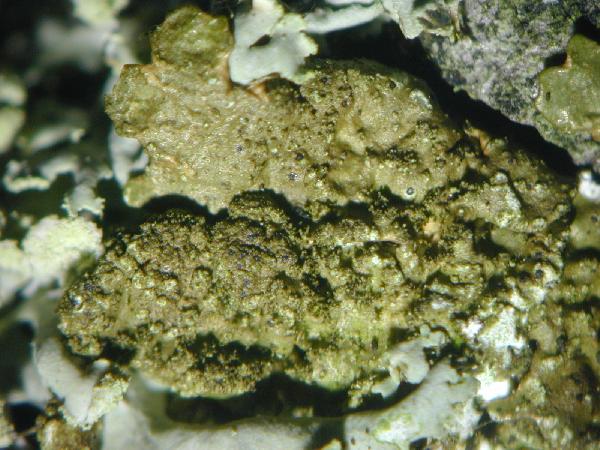Melanelixia subaurifera (Nyl.) O. Blanco, A. Crespo, Divakar, Essl., D. Hawksw. & Lumbsch
Mycol. Res., 108: 882, 2004. Basionym: Parmelia subaurifera Nyl. - Flora, 56: 22, 1873.
Synonyms: Melanelia subaurifera (Nyl.) Essl.; Parmelia olivacea var. subaurifera (Nyl.) O.J. Rich.
Description: Thallus foliose, heteromerous, dorsiventral, tightly adpressed throughout, forming 3-7(-10) cm wide rosettes, sorediate. Lobes discrete to more often contiguous, 2-4(-6) mm broad, flat, olive-green or olive-brown, smooth to rugulose in central parts, matt throughout (except sometimes in apical parts), with small, punctiform, yellowish, laminal soralia which often give rise to soft, globose to cylindrical, c. 0.25 mm tall, 0.02-0.06 mm thick isidioid outgrowths. Lower surface pale at margins, dark brown to black in central parts, with mostly simple, dark rhizines. Upper cortex paraplectenchymatous, with a pored epicortex, the cell walls containing isolichenan; medulla yellowish; lower cortex paraplectenchymatous. Apothecia very rare, lecanorine, with a brown disc and an often sorediate thalline margin. Epithecium brown; hymenium and hypothecium colourless. Asci 8-spored, clavate, the K/I+ blue tholus penetrated by a faintly amyloid apical cushion with parallel or diverging flanks, the wall K/I-, surrounded by a K/I+ blue outer layer, Lecanora-type. Ascospores 1-celled, hyaline, ellipsoid, 9-13 x 5-7 µm. Pycnidia rare, black, immersed, laminal. Conidia weakly fusiform to bacilliform, 5.5-7 x 1 µm Photobiont chlorococcoid. Spot tests: upper cortex K-, C-, KC-, P-, N-; medulla K-, C+ red, KC+ red, P-, UV-. Chemistry: medulla with lecanoric acid and subauriferin.
Growth form: Foliose, broad lobed
Substrata: bark
Photobiont: green algae other than Trentepohlia
Reproductive strategy: mainly asexual, by soredia, or soredia-like structures (e.g. blastidia)
Commonnes-rarity: (info)
Alpine belt: absent
Subalpine belt: very rare
Montane belt: rather common
Dry submediterranean belt: very common
Humid submediterranean belt: very common
Padanian area: very rare
pH of the substrata:
1 2 3 4 5
Solar irradiation:
1 2 3 4 5
Aridity:
1 2 3 4 5
Eutrophication:
1 2 3 4 5
Poleotolerance:
0 1 2 3
Altitudinal distribution:
1 2 3 4 5 6
Rarity
absent
extremely rare
very rare
rare
rather rare
rather common
common
very common
extremely common
Loading data...
Occurrence data
Predictive map
 Current prediction (1981-2010)
Current prediction (1981-2010) Future prediction (2071-2100) SSP 1-2.6
Future prediction (2071-2100) SSP 1-2.6 Future prediction (2071-2100) SSP 5-8.5Predictive maps according to Francesconi et al. 2025
Future prediction (2071-2100) SSP 5-8.5Predictive maps according to Francesconi et al. 2025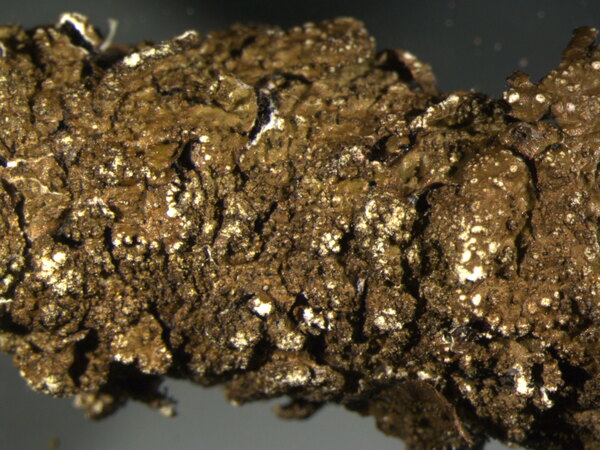
Juri Nascimbene; Owner: Department of Life Sciences, University of Trieste
Italy, Trentino-Alto Adige, Trento, Villa Welsperg, Centro Visitatori del Parco di Paneveggio; altitude: 1030 m
03.04.2009
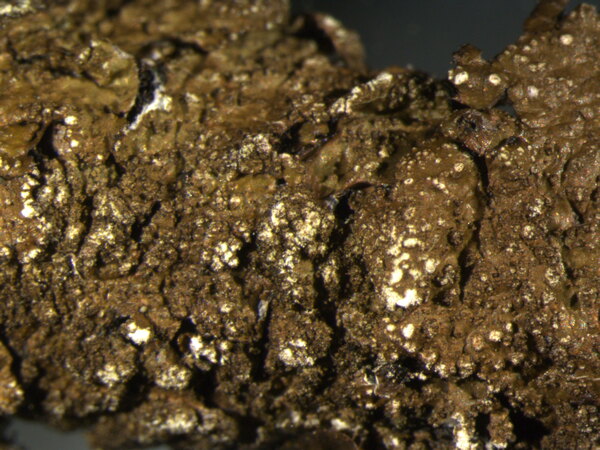
Juri Nascimbene; Owner: Department of Life Sciences, University of Trieste
Italy, Trentino-Alto Adige, Trento, Villa Welsperg, Centro Visitatori del Parco di Paneveggio; altitude: 1030 m
03.04.2009
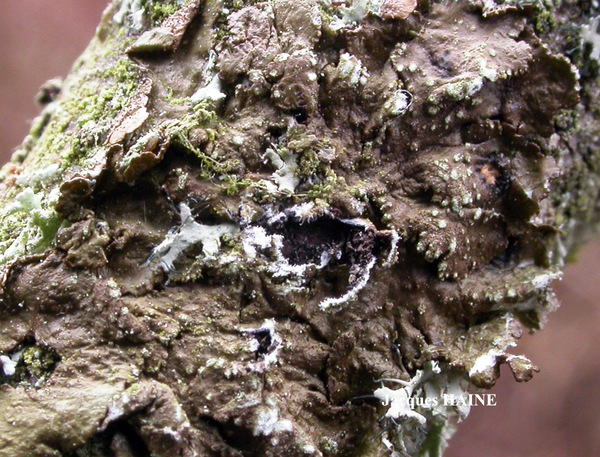
Jacques Haine - Source: http://www.lichensmaritimes.org/index.php?task=fiche&lichen=461&lang=en
France, Ardennes, Givet
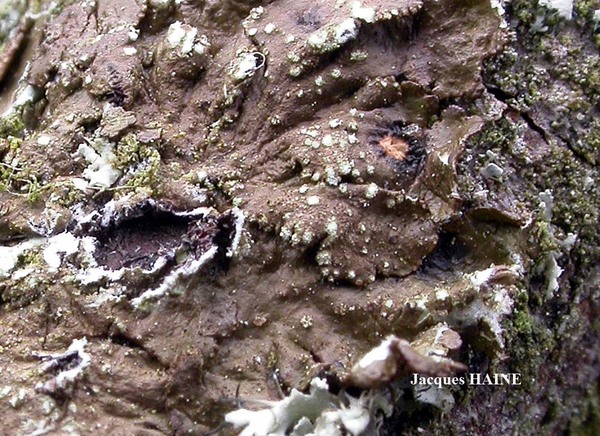
Jacques Haine - Source: http://www.lichensmaritimes.org/index.php?task=fiche&lichen=461&lang=en
France, Ardennes, Givet
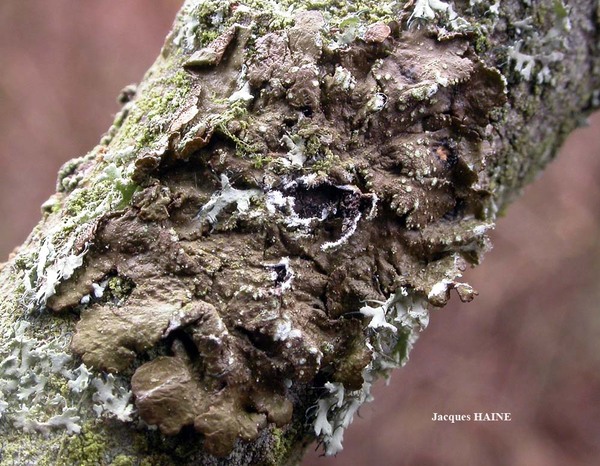
Jacques Haine - Source: http://www.lichensmaritimes.org/index.php?task=fiche&lichen=461&lang=en
France, Ardennes, Givet
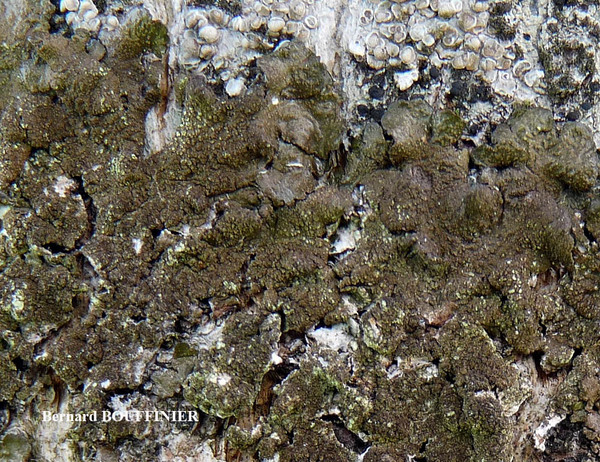
Bernard Bouffinier - Source: http://www.lichensmaritimes.org/index.php?task=fiche&lichen=461&lang=en
France, Le Faouet
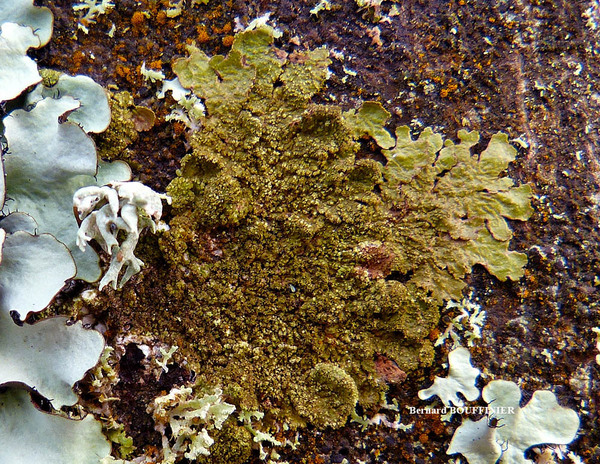
Bernard Bouffinier - Source: http://www.lichensmaritimes.org/index.php?task=fiche&lichen=461&lang=en
France, Le Fret
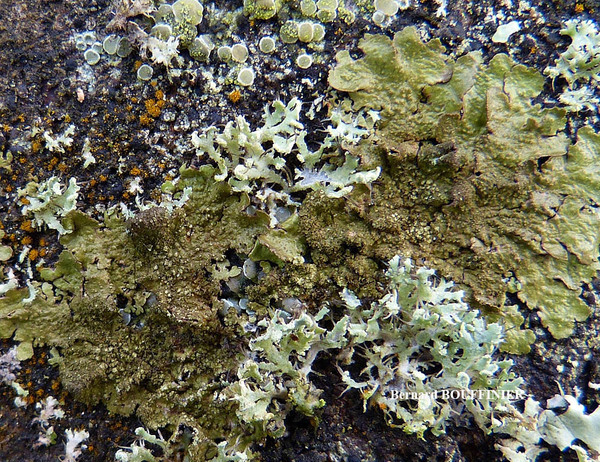
Bernard Bouffinier - Source: http://www.lichensmaritimes.org/index.php?task=fiche&lichen=461&lang=en
France, Le Fret
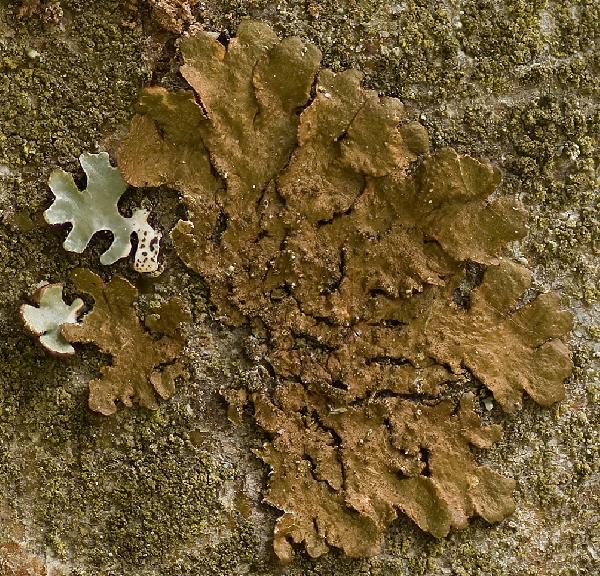
Ulrich Kirschbaum CC BY-SA 4.0 – Source: https://www.thm.de/lse/ulrich-kirschbaum/flechtenbilder
Central Europe; Germany: Hesse.
Growth form: Foliose, broad lobed
Substrata: bark
Photobiont: green algae other than Trentepohlia
Reproductive strategy: mainly asexual, by soredia, or soredia-like structures (e.g. blastidia)
Commonnes-rarity: (info)
Alpine belt: absent
Subalpine belt: very rare
Montane belt: rather common
Dry submediterranean belt: very common
Humid submediterranean belt: very common
Padanian area: very rare
pH of the substrata:
| 1 | 2 | 3 | 4 | 5 |
Solar irradiation:
| 1 | 2 | 3 | 4 | 5 |
Aridity:
| 1 | 2 | 3 | 4 | 5 |
Eutrophication:
| 1 | 2 | 3 | 4 | 5 |
Poleotolerance:
| 0 | 1 | 2 | 3 |
Altitudinal distribution:
| 1 | 2 | 3 | 4 | 5 | 6 |
Rarity
absent
extremely rare
very rare
rare
rather rare
rather common
common
very common
extremely common
Loading data...
Occurrence data
Predictive map
 Current prediction (1981-2010)
Current prediction (1981-2010) Future prediction (2071-2100) SSP 1-2.6
Future prediction (2071-2100) SSP 1-2.6 Future prediction (2071-2100) SSP 5-8.5
Future prediction (2071-2100) SSP 5-8.5Predictive maps according to Francesconi et al. 2025

Juri Nascimbene; Owner: Department of Life Sciences, University of Trieste
Italy, Trentino-Alto Adige, Trento, Villa Welsperg, Centro Visitatori del Parco di Paneveggio; altitude: 1030 m
03.04.2009

Juri Nascimbene; Owner: Department of Life Sciences, University of Trieste
Italy, Trentino-Alto Adige, Trento, Villa Welsperg, Centro Visitatori del Parco di Paneveggio; altitude: 1030 m
03.04.2009

Jacques Haine - Source: http://www.lichensmaritimes.org/index.php?task=fiche&lichen=461&lang=en
France, Ardennes, Givet

Jacques Haine - Source: http://www.lichensmaritimes.org/index.php?task=fiche&lichen=461&lang=en
France, Ardennes, Givet

Jacques Haine - Source: http://www.lichensmaritimes.org/index.php?task=fiche&lichen=461&lang=en
France, Ardennes, Givet

Bernard Bouffinier - Source: http://www.lichensmaritimes.org/index.php?task=fiche&lichen=461&lang=en
France, Le Faouet

Bernard Bouffinier - Source: http://www.lichensmaritimes.org/index.php?task=fiche&lichen=461&lang=en
France, Le Fret

Bernard Bouffinier - Source: http://www.lichensmaritimes.org/index.php?task=fiche&lichen=461&lang=en
France, Le Fret



